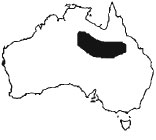Varanus Spenceri
Lucas & Frost 1903Spencer's goanna, plain goanna
 |
Spencer's· goannas usually shelter in burrows or large cracks in the clay and often inhabit areas devoid of trees (Stammer 1970; Swanson 1976). In captivity they are able to climb quite well (McKeown pers comm.) and so may explore trees where they are present. The adult females examined by Pengilley (1981) had eaten mammals, large snakes. agamids. mammals and insects (mainly orthopterans) . A specimen examined by Stammer (1970) contained large numbers of beetles. The stout bodies suggest that they are inactive throughout the winter, but there are no direct observations to substantiate this. Bipedal ritual combat in this species was first recorded by Waite ( 1929), who mistook them for perenties . (Horn 1981). A burrow, probably intended as a nest is depicted by Pengilley (1981).
There are few references to the care of this species in captivity (e.g. Peters 1969a,c, 1970a, 1971, 1986). They require a spacious terrarium which provides plenty of opportunities to dig and would probably benefit from a seasonal reduction in activity. Eggs laid by a wild caught female hatched after 133-140 days at 29°C (Peters 1986). juveniles are much more colourful than the adults, with bright yellow bands over a glossy brown back. They double in size within six weeks. In captivity, Spencer's goannas are said to be somewhat nervous but tolerant They can live for at least 15 years (Snider & Bowler 1992).
Attribution / Courtesy: Daniel Bennett. 1995. A Little Book of Monitor Lizards. Viper Press U.K.




